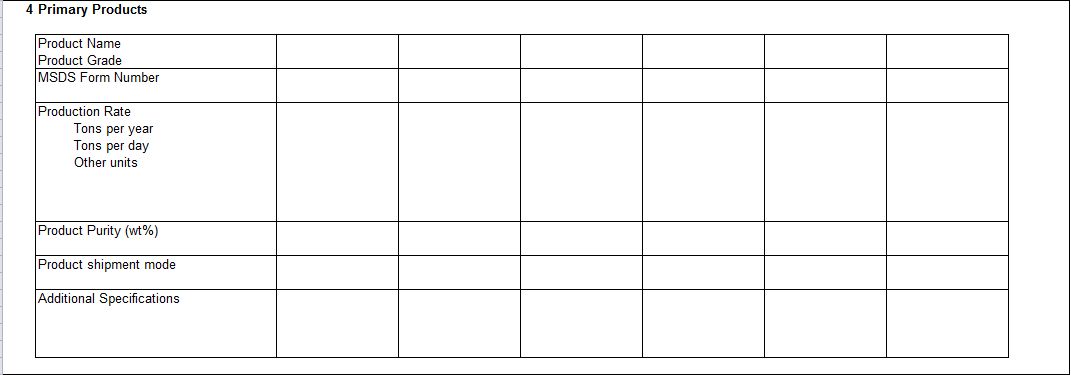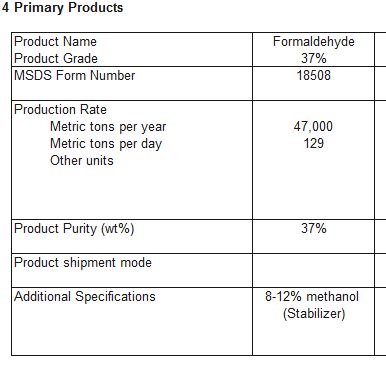Define product and feed: Difference between revisions
Sean Kelton (talk | contribs) |
TJConsidine (talk | contribs) No edit summary |
||
| Line 7: | Line 7: | ||
==Primary Raw Materials== |
==Primary Raw Materials== |
||
The definition of raw materials on the Design Basis is located in Section 5 (see image). There are 6 main categories: Feedstock name and grade, MSDS form number, Feedstock availability, Feedstock price, Known feedstock impurities, and Additional specifications. It is of vital importance to recognize that when deciding upon feed specifications, not only stoichiometric chemistry should be considered, but also safety, yield, and environmental hazards (Biegler, 14). |
The definition of raw materials on the Design Basis is located in Section 5 (see image). There are 6 main categories: Feedstock name and grade, MSDS form number, Feedstock availability, Feedstock price, Known feedstock impurities, and Additional specifications. It is of vital importance to recognize that when deciding upon feed specifications, not only stoichiometric chemistry should be considered, but also safety, yield, and environmental hazards (Biegler, 14). An example Raw Material section of the Design Basis is shown below. |
||
[[File:feed.png]] |
[[File:feed.png]] |
||
Figure 1: An example Raw Material section. Taken from Team Born Sinner's (written by Sean Kelton, Michael Gleeson, Thomas Considine and James Xamplas) final report for ChE 351 with J. Cole. Report was submitted on 11/27/13 |
|||
Figure 1: An example Raw Material section. |
|||
Each component of the feed, once decided upon, must be entered in the Design Basis section: |
Each component of the feed, once decided upon, must be entered in the Design Basis section: |
||
Revision as of 22:35, 2 February 2014
Authors: Michael Gleeson, Sean Kelton, Thomas Considine
Introduction
A key step in the initial phases of chemical process design is the project definition. Along with the customer definition and location of the facility, the definition of the key feeds and products is important[1] (Towler, 17). Both feed and product specifications are found in the Design Basis, a non-exhaustive document containing key information and details of the plant and process.
Primary Raw Materials
The definition of raw materials on the Design Basis is located in Section 5 (see image). There are 6 main categories: Feedstock name and grade, MSDS form number, Feedstock availability, Feedstock price, Known feedstock impurities, and Additional specifications. It is of vital importance to recognize that when deciding upon feed specifications, not only stoichiometric chemistry should be considered, but also safety, yield, and environmental hazards (Biegler, 14). An example Raw Material section of the Design Basis is shown below.
Figure 1: An example Raw Material section. Taken from Team Born Sinner's (written by Sean Kelton, Michael Gleeson, Thomas Considine and James Xamplas) final report for ChE 351 with J. Cole. Report was submitted on 11/27/13
Each component of the feed, once decided upon, must be entered in the Design Basis section:
Feedstock name and grade
In this section, the the name of each component of the feed is entered. Along with the generic name of the compound, its formal chemical name, as well as grade should be included. Again, no feedstock available in industry will have 100% purity. The most common grade will be "technical" or "industrial". However, "laboratory" or "reagent" grade (higher purity) is less common.
MSDS form number
The MSDS (material safety data sheet) is an important part of dealing with any compound, with regards to operational hazards. In this section, the specific MSDS number of each component must be listed so as to be readily available in case more information is requested. MSDSs contain key physical data, such as flash point, melting point, etc.; as well as information on storage and disposal. Sources such as Perry's Chemical Engineers' Handbook also contains sources of flammability hazards of many chemicals (Seider 37).
Feedstock availability
The availability of each feedstock must also be recorded. Whether on a per year or per day basis depends primarily on the frequency of use of each specific material. This information is dependent on the overall production rate of the facility.
Feedstock price
The price of each material is listed in this sub-section. This information is highly relevant when completing the economic analysis. Note that feedstock price is highly dependent on quantity purchased. Often, the quotes of bulk chemical prices must be obtained directly from suppliers.
Known feedstock impurities
Along with the general feedstock grade (recorded in the Feedstock name and grade sub-section), the specific known impurities are recorded in this section. The name of each compound (commonly water, minerals, etc.) is recorded along with their concentrations in ppmw. The impurities are listed with the sale of the feedstock product.
Additional specifications
Any additional pertinent information about the feedstock is listed in this section. Examples include potential alternatives sources or uses.
Primary Products
The Primary Products are defined in Section 4 for the Design Basis (Please see example image below). There are 6 important subsections that must be completed within the design basis when defining the products: product name and grade, MSDS form number, production rate, product purity, product shipment mode, and additional specifications.
Each individual product that will result from the process, including wastes and side products, must be entered in the primary products section of the Design Basis.
Figure 2: Primary Products Definition Section
Product Name & Grade
In this section of the design basis, the name of each product formed within the process is enter. First will be the primary desired product formed within the process followed by any side products or important waste products formed. Additionally, the desired purity (or grade) of each of these products should be specified. For example, if the product is completely pure is would be 100% grade. However, if the process creates Hydrochloric Acid in a 30% aqueous solution with water as a stabilizer, then the grade would be 30% and so on. Typically grades close to 100% are not attainable without excessive processing and thus lower grades are outputted to balance the trade-off between processing costs and purity.
MSDS Form Number
It is critical that the MSDS form be included in the design basis. The MSDS contains crucial information about the chemicals being produced including but not limited to safety/hazards information, actions to take in case of a spill/emergency, first aid measures, storage procedures, and basic material properties. This information is vital to the health of employees and safety within the plant and must be available for reference at any time throughout the design process. In order to have this information readily accessible, the MSDS form numbers should be inputted for each product in this section.
Production Rate
For any particular chemical process design, the design team is typically given a specified level of production output from which the level of production input is calculated. In other cases, there is a specified level of inputs available for use. If this is the case then, the production rate should be derived from material balances calculated using the stoichiometry of the reaction(s) or levels of inputs available in any given time period (day, week, year, etc.) multiplied by an efficiency factor. As an alternative, the final production rate can be obtained by looking at the output streams in the stream tables after simulating your process in specialized software (Turton p.24-25).
The rate of product formation should be listed at both a daily and yearly rate, in order to allow for ease of calculations later when computing process economics. The production rate should be listed in other rates as well if they are critical to the design of the plant. For example if the design problem is given with a desired weekly production rate, then that should be listed here.
Product Purity
The product purity is the same as the product grade, listed here as a weight percentage (100% is pure), unless different purity levels are needed in which case the most pure is listed here (grade then lists the required purity level and each diluted level in addition). The product purity is critical in process formulation in order to define the desired level and efficiency of separation processes needed within the process.
Product Shipment Mode
Product shipment mode specifies how the product will be moved from production to distribution centers or customers. In this section additional specifications in terms of safety recommendations or handling requirements should be clearly laid out for this product.
Additional Specifications
In this section any further pertinent information to the process design or given within the design statement should be listed. Again the main purpose of this section is to ensure that the main requirements for the process design are all clearly laid out within one easily referenced document.
Case Study
As a case study, consider a plant which requires 50,000 tonnes/year of 37% formaldehyde in water (containing 8-12 wt% methanol as a stabilizer). Below is the product and feed definition of this process.
Figure 3: Product definition
Figure 4: Feed definition
Conclusion
Within the Design Basis, the definition and description of the product and feed streams is of utmost importance. Included in these sections are the names of the components, as well as their prices and key characteristics (i.e., chemical purity and grade, MSDS information, etc.). The product and feed definition is essential both in the initial and final stages of plant and process design, as it serves as a starting ground for facility design, as well as a reference of all the key components in the plant.
References
1. G.P. Towler, R. Sinnott, Chemical Engineering Design: Principles, Practice and Economics of Plant and Process Design, Elsevier, 2012.
2. L.T. Biegler, I.E. Grossmann, A.W. Westerberg, Systematic Methods of Chemical Process Design, Prentice-Hall: Upper Saddle River, 1997.
3. W.D. Sieder, J.D. Seader, D.R. Lewin, Process Design Principles: Synthesis, Analysis, and Evaluation, Wiley: New York, 2004.
4. R.T. Turton, R.C. Bailie, W.B. Whiting, J.A. Shaeiwitz, Analysis, Synthesis, and Design of Chemical Processes, Prentice Hall: Upper Saddle River, 2003.



